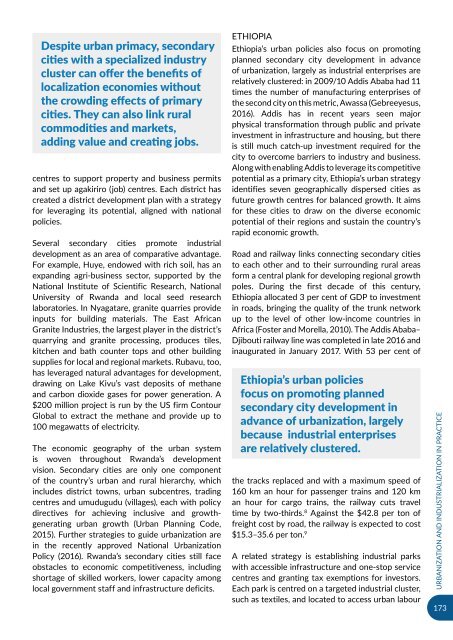URBANIZATION AND INDUSTRIALIZATION
Economic%20Report%20on%20Africa%202017%20UNECA
Economic%20Report%20on%20Africa%202017%20UNECA
You also want an ePaper? Increase the reach of your titles
YUMPU automatically turns print PDFs into web optimized ePapers that Google loves.
Despite urban primacy, secondary<br />
cities with a specialized industry<br />
cluster can offer the benefits of<br />
localization economies without<br />
the crowding effects of primary<br />
cities. They can also link rural<br />
commodities and markets,<br />
adding value and creating jobs.<br />
centres to support property and business permits<br />
and set up agakiriro (job) centres. Each district has<br />
created a district development plan with a strategy<br />
for leveraging its potential, aligned with national<br />
policies.<br />
Several secondary cities promote industrial<br />
development as an area of comparative advantage.<br />
For example, Huye, endowed with rich soil, has an<br />
expanding agri-business sector, supported by the<br />
National Institute of Scientific Research, National<br />
University of Rwanda and local seed research<br />
laboratories. In Nyagatare, granite quarries provide<br />
inputs for building materials. The East African<br />
Granite Industries, the largest player in the district’s<br />
quarrying and granite processing, produces tiles,<br />
kitchen and bath counter tops and other building<br />
supplies for local and regional markets. Rubavu, too,<br />
has leveraged natural advantages for development,<br />
drawing on Lake Kivu’s vast deposits of methane<br />
and carbon dioxide gases for power generation. A<br />
$200 million project is run by the US firm Contour<br />
Global to extract the methane and provide up to<br />
100 megawatts of electricity.<br />
The economic geography of the urban system<br />
is woven throughout Rwanda’s development<br />
vision. Secondary cities are only one component<br />
of the country’s urban and rural hierarchy, which<br />
includes district towns, urban subcentres, trading<br />
centres and umudugudu (villages), each with policy<br />
directives for achieving inclusive and growthgenerating<br />
urban growth (Urban Planning Code,<br />
2015). Further strategies to guide urbanization are<br />
in the recently approved National Urbanization<br />
Policy (2016). Rwanda’s secondary cities still face<br />
obstacles to economic competitiveness, including<br />
shortage of skilled workers, lower capacity among<br />
local government staff and infrastructure deficits.<br />
ETHIOPIA<br />
Ethiopia’s urban policies also focus on promoting<br />
planned secondary city development in advance<br />
of urbanization, largely as industrial enterprises are<br />
relatively clustered: in 2009/10 Addis Ababa had 11<br />
times the number of manufacturing enterprises of<br />
the second city on this metric, Awassa (Gebreeyesus,<br />
2016). Addis has in recent years seen major<br />
physical transformation through public and private<br />
investment in infrastructure and housing, but there<br />
is still much catch-up investment required for the<br />
city to overcome barriers to industry and business.<br />
Along with enabling Addis to leverage its competitive<br />
potential as a primary city, Ethiopia’s urban strategy<br />
identifies seven geographically dispersed cities as<br />
future growth centres for balanced growth. It aims<br />
for these cities to draw on the diverse economic<br />
potential of their regions and sustain the country’s<br />
rapid economic growth.<br />
Road and railway links connecting secondary cities<br />
to each other and to their surrounding rural areas<br />
form a central plank for developing regional growth<br />
poles. During the first decade of this century,<br />
Ethiopia allocated 3 per cent of GDP to investment<br />
in roads, bringing the quality of the trunk network<br />
up to the level of other low-income countries in<br />
Africa (Foster and Morella, 2010). The Addis Ababa–<br />
Djibouti railway line was completed in late 2016 and<br />
inaugurated in January 2017. With 53 per cent of<br />
Ethiopia’s urban policies<br />
focus on promoting planned<br />
secondary city development in<br />
advance of urbanization, largely<br />
because industrial enterprises<br />
are relatively clustered.<br />
the tracks replaced and with a maximum speed of<br />
160 km an hour for passenger trains and 120 km<br />
an hour for cargo trains, the railway cuts travel<br />
time by two-thirds. 8 Against the $42.8 per ton of<br />
freight cost by road, the railway is expected to cost<br />
$15.3–35.6 per ton. 9<br />
A related strategy is establishing industrial parks<br />
with accessible infrastructure and one-stop service<br />
centres and granting tax exemptions for investors.<br />
Each park is centred on a targeted industrial cluster,<br />
such as textiles, and located to access urban labour<br />
<strong>URBANIZATION</strong> <strong>AND</strong> <strong>INDUSTRIALIZATION</strong> IN PRACTICE<br />
173


